Related Research Articles

Igor Fyodorovich Stravinsky was a Russian composer and conductor with French citizenship and United States citizenship. He is widely considered one of the most important and influential composers of the 20th century and a pivotal figure in modernist music.

Prince Igor is an opera in four acts with a prologue, written and composed by Alexander Borodin. The composer adapted the libretto from the early Russian epic The Lay of Igor's Host, which recounts the campaign of the 12th-century prince Igor Svyatoslavich against the invading Cuman ("Polovtsian") tribes in 1185. He also incorporated material drawn from two medieval Kievan chronicles. The opera was left unfinished upon the composer's death in 1887 and was edited and completed by Nikolai Rimsky-Korsakov and Alexander Glazunov. It was first performed in St. Petersburg, Russia, in 1890.

Nikolai Andreyevich Rimsky-Korsakov was a Russian composer, a member of the group of composers known as The Five. He was a master of orchestration. His best-known orchestral compositions—Capriccio Espagnol, the Russian Easter Festival Overture, and the symphonic suite Scheherazade—are staples of the classical music repertoire, along with suites and excerpts from some of his 15 operas. Scheherazade is an example of his frequent use of fairy-tale and folk subjects.
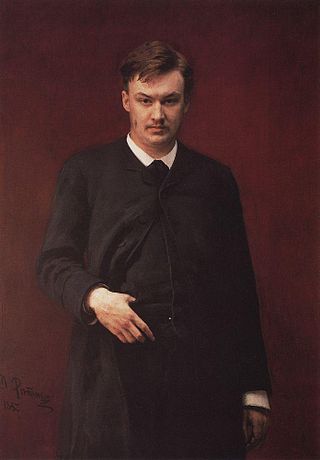
Alexander Konstantinovich Glazunov was a Russian composer, music teacher, and conductor of the late Russian Romantic period. He was director of the Saint Petersburg Conservatory between 1905 and 1928 and was instrumental in the reorganization of the institute into the Petrograd Conservatory, then the Leningrad Conservatory, following the Bolshevik Revolution. He continued as head of the Conservatory until 1930, though he had left the Soviet Union in 1928 and did not return. The best-known student under his tenure during the early Soviet years was Dmitri Shostakovich.

Capriccio espagnol, Op. 34, is the common Western title for a five movement orchestral suite, based on Spanish folk melodies, composed by the Russian composer Nikolai Rimsky-Korsakov in 1887. It received its premiere on 31 October 1887, in St. Petersburg, performed by the Imperial Orchestra conducted by the composer. Rimsky-Korsakov originally intended to write the work for a solo violin with orchestra, but later decided that a purely orchestral work would do better justice to the lively melodies. The Russian title is Каприччио на испанские темы.
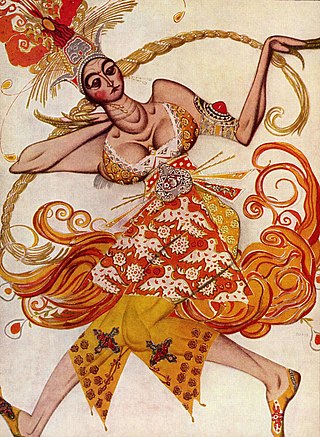
The Firebird is a ballet and orchestral concert work by the Russian composer Igor Stravinsky. It was written for the 1910 Paris season of Sergei Diaghilev's Ballets Russes company; the original choreography was by Michel Fokine, who collaborated with Alexandre Benois and others on a scenario based on the Russian fairy tales of the Firebird and the blessing and curse it possesses for its owner. It was first performed at the Opéra de Paris on 25 June 1910 and was an immediate success, catapulting Stravinsky to international fame and leading to future Diaghilev–Stravinsky collaborations including Petrushka (1911) and The Rite of Spring (1913).
Feu d'artifice, Op. 4 is a composition by Igor Stravinsky, written in 1908 and described by the composer as a "short orchestral fantasy." It usually takes less than four minutes to perform.

The Symphony No. 1 in D minor, Op. 13, is a four-movement composition for orchestra written from January to October 1895 by the Russian composer Sergei Rachmaninoff. He composed it at his Ivanovka estate near Tambov, Russia. Despite its poor initial reception, the symphony is now seen as a dynamic representation of the Russian symphonic tradition, with British composer Robert Simpson calling it "a powerful work in its own right, stemming from Borodin and Tchaikovsky, but convinced, individual, finely constructed, and achieving a genuinely tragic and heroic expression that stands far above the pathos of his later music."
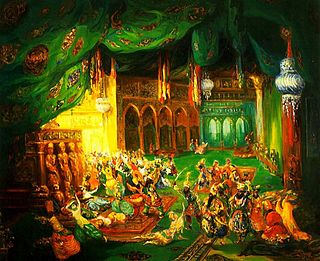
Scheherazade, also commonly Sheherazade, Op. 35, is a symphonic suite composed by Nikolai Rimsky-Korsakov in 1888 and based on One Thousand and One Nights.

Igor Stravinsky's Violin Concerto in D is a neoclassical violin concerto in four movements, composed in the summer of 1931 and premiered on October 23, 1931. It lasts approximately twenty minutes.

Maximilian Osseyevich Steinberg was a Russian composer of classical music.
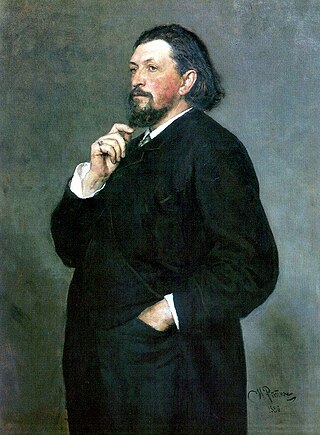
The Russian Symphony Concerts were a series of Russian classical music concerts hosted by timber magnate and musical philanthropist Mitrofan Belyayev in St. Petersburg as a forum for young Russian composers to have their orchestral works performed. While a number of works by these composers were performed, pieces written by composers of the previous generation such as Nikolai Rimsky-Korsakov and Mily Balakirev were also played there.
Alexander Glazunov wrote his Symphony No. 1 in E major, Op. 5, in 1881, when he was 16 years old. It was premiered the following year in St. Petersburg. It is known as his Slavonian Symphony.
The Belyayev circle was a society of Russian musicians who met in Saint Petersburg, Russia between 1885 and 1908, and whose members included Nikolai Rimsky-Korsakov, Alexander Glazunov, Vladimir Stasov, Anatoly Lyadov, Alexander Ossovsky, Witold Maliszewski, Nikolai Tcherepnin, Nikolay Sokolov, Alexander Winkler among others. The circle was named after Mitrofan Belyayev, a timber merchant and amateur musician who became a music philanthropist and publisher after hearing the music of the teenage Glazunov.
In classical music, it is relatively rare for a work to be written in collaboration by multiple composers. This contrasts with popular music, where it is common for more than one person to contribute to the music for a song. Nevertheless, there are instances of collaborative classical music compositions.

Pyotr Ilyich Tchaikovsky's relations with the group of composers known as the Belyayev circle, which lasted from 1887 until Tchaikovsky's death in 1893, influenced all of their music and briefly helped shape the next generation of Russian composers. This group was named after timber merchant Mitrofan Belyayev, an amateur musician who became an influential music patron and publisher after he had taken an interest in Alexander Glazunov's work. By 1887, Tchaikovsky was firmly established as one of the leading composers in Russia. A favorite of Tsar Alexander III, he was widely regarded as a national treasure. He was in demand as a guest conductor in Russia and Western Europe, and in 1890 visited the United States in the same capacity. By contrast, the fortunes of the nationalistic group of composers known as The Five, which preceded the Belyayev circle, had waned, and the group had long since dispersed; of its members, only Nikolai Rimsky-Korsakov remained fully active as a composer. Now a professor of musical composition and orchestration at the Saint Petersburg Conservatory, Rimsky-Korsakov had become a firm believer in the Western-based compositional training that had been once frowned upon by the group.
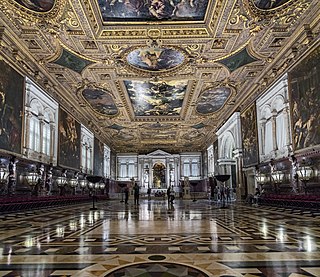
Threni: id est Lamentationes Jeremiae Prophetae, usually referred to simply as Threni, is a musical setting by Igor Stravinsky of verses from the Book of Lamentations in the Latin of the Vulgate, for solo singers, chorus and orchestra. It is important among Stravinsky's compositions as his first and longest completely dodecaphonic work, but is not often performed. It has been described as "austere" but also as a "culminating point" in his career as an artist, "important both spiritually and stylistically" and "the most ambitious and structurally the most complex" of all his religious compositions, and even "among Stravinsky's greatest works".
The Piano Sonata in F-sharp minor is an early composition by Russian composer Igor Stravinsky. It was composed between 1903 and 1904 and is dedicated to Nicolas Richter.
Scherzo fantastique, op. 3, composed in 1908, is the second purely orchestral work by Igor Stravinsky. Despite the composer's later description of the work as "a piece of 'pure', symphonic music", the work was inspired by Maurice Maeterlinck's 1901 essay "La Vie des Abeilles", as is made clear in a letter of 18 June 1907 from the composer to his teacher Rimsky-Korsakov. Ten years later, Léo Staats adapted it as a ballet for the Opéra Garnier, with the title Les Abeilles, which was objected to by Maeterlinck.
References
- 1 2 3 4 Walsh, Stephen (1988). The Music of Stravinsky. Oxford: Oxford University Press. pp. 8–11. ISBN 0-19-816375-4.
- 1 2 3 4 5 White, Eric Walter (1979). Stravinsky: the Composer and his Works (2nd ed.). Berkeley and Los Angeles: University of California Press. pp. 29 &, 176–177. ISBN 0-520-03985-8.
- ↑ Works of Igor Stravinsky. 22-CD set. Sony Classical 88697103112. New York: Sony BMG Music Entertainment, 2007. Disc 8, "Stravinsky – Symphony in E-flat, Rehearsals & Talks" 88697103112-08.